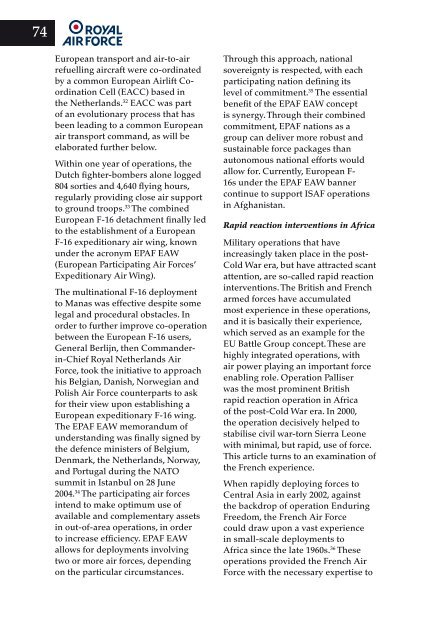You also want an ePaper? Increase the reach of your titles
YUMPU automatically turns print PDFs into web optimized ePapers that Google loves.
74<br />
European transport and air-to-air<br />
refuelling aircraft were co-ordinated<br />
by a common European <strong>Air</strong>lift Coordination<br />
Cell (EACC) based in<br />
the Netherlands. 32 EACC was part<br />
of an evolutionary process that has<br />
been leading to a common European<br />
air transport command, as will be<br />
elaborated further below.<br />
Within one year of operations, the<br />
Dutch fighter-bombers alone logged<br />
804 sorties and 4,640 flying hours,<br />
regularly providing close air support<br />
to ground troops. 33 The combined<br />
European F-16 detachment finally led<br />
to the establishment of a European<br />
F-16 expeditionary air wing, known<br />
under the acronym EPAF EAW<br />
(European Participating <strong>Air</strong> Forces’<br />
Expeditionary <strong>Air</strong> Wing).<br />
The multinational F-16 deployment<br />
to Manas was effective despite some<br />
legal and procedural obstacles. In<br />
order to further improve co-operation<br />
between the European F-16 users,<br />
General Berlijn, then Commanderin-Chief<br />
Royal Netherlands <strong>Air</strong><br />
Force, took the initiative to approach<br />
his Belgian, Danish, Norwegian and<br />
Polish <strong>Air</strong> Force counterparts to ask<br />
for their view upon establishing a<br />
European expeditionary F-16 wing.<br />
The EPAF EAW memorandum of<br />
understanding was finally signed by<br />
the defence ministers of Belgium,<br />
Denmark, the Netherlands, Norway,<br />
and Portugal during the NATO<br />
summit in Istanbul on 28 June<br />
2004. 34 The participating air forces<br />
intend to make optimum use of<br />
available and complementary assets<br />
in out-of-area operations, in order<br />
to increase efficiency. EPAF EAW<br />
allows for deployments involving<br />
two or more air forces, depending<br />
on the particular circumstances.<br />
Through this approach, national<br />
sovereignty is respected, with each<br />
participating nation defining its<br />
level of commitment. 35 The essential<br />
benefit of the EPAF EAW concept<br />
is synergy. Through their combined<br />
commitment, EPAF nations as a<br />
group can deliver more robust and<br />
sustainable force packages than<br />
autonomous national efforts would<br />
allow for. Currently, European F-<br />
16s under the EPAF EAW banner<br />
continue to support ISAF operations<br />
in Afghanistan.<br />
Rapid reaction interventions in Africa<br />
Military operations that have<br />
increasingly taken place in the post-<br />
Cold War era, but have attracted scant<br />
attention, are so-called rapid reaction<br />
interventions. The British and French<br />
armed forces have accumulated<br />
most experience in these operations,<br />
and it is basically their experience,<br />
which served as an example for the<br />
EU Battle Group concept. These are<br />
highly integrated operations, with<br />
air power playing an important force<br />
enabling role. Operation Palliser<br />
was the most prominent British<br />
rapid reaction operation in Africa<br />
of the post-Cold War era. In 2000,<br />
the operation decisively helped to<br />
stabilise civil war-torn Sierra Leone<br />
with minimal, but rapid, use of force.<br />
This article turns to an examination of<br />
the French experience.<br />
When rapidly deploying forces to<br />
Central Asia in early 2002, against<br />
the backdrop of operation Enduring<br />
Freedom, the French <strong>Air</strong> Force<br />
could draw upon a vast experience<br />
in small-scale deployments to<br />
Africa since the late 1960s. 36 These<br />
operations provided the French <strong>Air</strong><br />
Force with the necessary expertise to

















